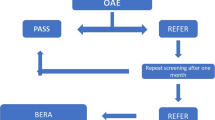Abstract
Hearing plays a basic and important role in language, speech and intellectual development. A hearing impaired child develops psychological, social, educational and cognitive problems. The aim is to evaluate the hearing in high-risk neonates using BERA. 50 High risk admissions in the NICU and high- risk infants presenting to the OPD of our hospital for a period of 2 years were included in the study. Of the 50 high-risk infants, 44 (88%) cases had impaired BERA, remaining 6 (12%) had normal hearing threshold. LBW and hyperbilirubinemia were found to have strong relationship with hearing impairment (p value 0.04 and 0.03 respectively) and OR of 1.98 and 1.75 respectively. Elevated auditory threshold was found more frequently in infants with multiple clinical adverse factors than in those having single risk factor (36/50 vs. 8/50, p < 0.009). Proportion of infants with impaired BERA was high in infants with low birth weight and hyperbilirubinemia in exchange range. Screening by BERA at an early age is beneficial for early diagnosis of hearing impairment, so that possible interventions can be used as early as possible and prevent developmental delays in newborns.

Similar content being viewed by others
References
Behrman RE, Kliegman R, Jenson HB (2007) Nelson textbook of pediatrics, 18th edn. WB Saunders, Philadelphia, pp 2620–2628
Rahul KS, Michael CL, Glenn CI (2011) Hearing impairment clinical presentation. Medscape Reference
Mitchell RB, Pereira KD (eds.) (2009) Pediatric otolaryngology for the clinician. Springer, Berlin. https://doi.org/10.1007/978-1-60327-127-1_2
Fakhraee SH, Kazemian M, Amidieh AA (2004) Hearing assessment of the high risk neonates admitted to Mofid hospital for children during 2001–2002, using auditory brainstem response (ABR). Arch Iran Med 7(1):44–46
Centers for Disease Control and Prevention National Center on Birth Defects and Developmental Disabilities. Hearing loss. Accessed at https://www.cdc.gov/nebddd/dd/ddhi.htm
Yoshinaga- IC (2003) Early Intervention after universal neonatal hearing screening impact on outcomes. Ment Retard Dev Disabil Res Rev 9(4):252–266
Bess FH, Paradise JL (1994) Universal Screening for infant hearing impairment; not simple, not risk-free, not necessarily beneficial, and not presently justified. Pediatrics 93(2):330
Sharma P, Chhangani NP, Meena KR, Jora R, Sharma N, Gupta BD (2006) Brainstem evoked response audiometry (BAER) in neonates with hyperbilirubinemia. Indian J Pediatr 73:413–416
Zamani A, Daneshjou K, Ameni A, Takand J (2004) Estimating the incidence of neonatal hearing loss in high risk neonates. Acta MedicaIranica 42(3):176–180
Chadha S, Bais AS (1997) Auditory brainstem responses in high risk and normal newborns. Indian J Pediatr 64:777–784
Aiyer RG, Parikh B (2009) Evaluation of auditory brainstem responses for hearing screening of high-risk infants. Indian J Otolaryngol Head Neck Surg 61:47–53
vanStraaten HL (1999) Automated auditory brainstem response in neonatal hearing screening. Acta Paediatr Suppl 88(432):76–79. https://doi.org/10.1111/j.1651-2227.1999.tb01165.x
Shannon DA, Felix JK, Krumholz A, Goldstein PJ, Harris KC (1984) Hearing screening of high-risk newborns with brainstem auditory evoked potentials: a follow-up study. Pediatrics 73(1):22–26
CIH (2007) Position statement significant changes. Available from http://www.jcih.org/posstatemts.htm
Duara S, Suter CM, Bessard KK, Gutberlet RL (1986) Neonatal screening with auditory brainstem responses: results of follow-up audiometry and risk factor evaluation. J Pediatr 108(2):276–281. https://doi.org/10.1016/s0022-3476(86)81004-6
Leech RW, Alvird EC (1997) Anoxic-ischemic encephalopathy in the human neonatal period. The significance of brainstem involvement. Arch Neurol 34(2):109–113
Lakshmi T, Zaheera Sultana S, Brid SV (2014) Evoked response audiometry in high risk infants. Int J Recent Trends Sci Technol 12(1):08–12
Author information
Authors and Affiliations
Corresponding author
Ethics declarations
Conflict of interest
The authors declare that they have no conflict of interest.
Ethical Approval
Obtained from the ethical committee of our institution.
Additional information
Publisher's Note
Springer Nature remains neutral with regard to jurisdictional claims in published maps and institutional affiliations.
Rights and permissions
About this article
Cite this article
Champion, S. Assessment of Hearing in High Risk Infants, Using Brainstem Evoked Response Audiometry. Indian J Otolaryngol Head Neck Surg 73, 383–388 (2021). https://doi.org/10.1007/s12070-020-02363-1
Received:
Accepted:
Published:
Issue Date:
DOI: https://doi.org/10.1007/s12070-020-02363-1




